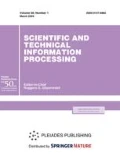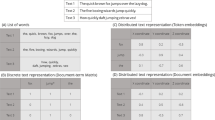Abstract
This paper considers the best-known tools for linguistic and statistical analysis of text corpora and introduces the RSA machine, which is a novel text analysis tool for socio-humanitarian research. The machine architecture and developing tools of the RSA machine are described. The results of a pilot study of texts using the RSA machine are presented. The pilot study of the capabilities of the new tool was carried out on the basis of 142 essay texts written on the theme “I. Others. World.” The performed correlation analysis revealed some relations between extracted texts attributes detected using the RSA machine (e.g. the frequency of predicate types and syntaxeme types) and psychodiagnostic research data, in particular, that on the level of aggressiveness. A scheme for interpreting predicate analysis data is proposed, which allows us to describe the specifics of speech-cognitive activity and worldview depending on the group and personal characteristics of the authors of the texts.




Similar content being viewed by others
Notes
REFERENCES
Enikolopov, S.N., Kuznetsova, Yu.M., Smirnov, I.V., Isakov, V.A., Stankevich, M.A., and Chudova, N.V., Creation of a tool for automatic text analysis for purposes of socio-humanitarian research. Part 1, Iskusstv. Intell. Prinyatie Reshenii, 2019, no. 2, pp. 28–38.
Heiden, S., The TXM platform: Building open-source textual analysis software compatible with the TEI encoding scheme, 24th Pacific Asia Conference on Language, Information and Computation, Waseda University, 2010, pp. 389–398.
Kilgarriff, A., et al., The sketch engine: Ten years on, Lexicography, 2014, vol. 1, no. 1, pp. 7–36.
Evert, S. and Hardie, A., Twenty-first century corpus workbench: Updating a query architecture for the new millennium, Proceedings of the Proceedings of the Corpus Linguistics 2011 Conference, Birmingham, UK, 2011.
Zolotova, G.A., Sintaksicheskii slovar’: Repertuar ehlementarnykh edinits russkogo sintaksisa (Syntax Dictionary: The Repertoire of Elementary Units of Russian Syntax), Moscow: Editorial URSS, 3rd ed.
Funding
This work was supported by the Ministry of Science and Higher Education of the Russian Federation, project no. 075-15-2020-799.
Author information
Authors and Affiliations
Corresponding author
Ethics declarations
The authors declare that they have no conflicts of interest.
Additional information
Translated by L. Solovyova
About this article
Cite this article
Kuznetsova, Y.M., Smirnov, I.V., Stankevich, M.A. et al. Creating a Text Analysis Tool for Socio-Humanitarian Research. Part 2. The RSA Machine and the Experience in Using It. Sci. Tech. Inf. Proc. 47, 374–382 (2020). https://doi.org/10.3103/S0147688220060040
Received:
Published:
Issue Date:
DOI: https://doi.org/10.3103/S0147688220060040




